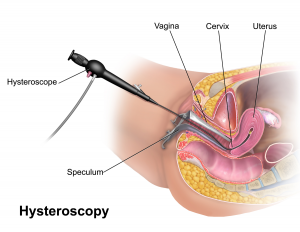Laparoscopy is a way of performing surgery. Instead of making a large incision (or cut) for certain operations, surgeons make tiny incisions and insert thin instruments and a camera into an area, such as into the abdomen, to view the internal organs and repair or remove tissue.

With laparoscopy, tiny fiber-optic instruments are inserted into the body through small surgical openings (thus the name “keyhole”). A person may have one or more small incisions. A video camera is inserted into the opening, which guides the surgeon who is manipulating the instruments in any other openings. Sometimes, only one incision is used and all the instruments are placed into it. This is called single incision laparoscopic surgery or SILS. On the ends of these instruments are such devices as scissors, surgical staplers, scalpels, and sutures (stitches). Abdominal laparoscopy involves the following steps:
- Once the patient is asleep, the surgeon makes a small cut near or at the navel and inserts a thin, hollow tube called a trocar. The tube extends from inside the abdomen to the outside.
- Carbon dioxide gas is injected into the abdomen to expand it and allow the doctor more room to view the organs.
- The laparoscope, a medical instrument with a high-intensity light and very tiny camera, is inserted into the abdomen through the trocar. The surgeon views a large image from the camera on a TV screen in the operating room.
- Other instruments are inserted into small incisions. The surgeon manipulates these to perform the procedure, whether it is removing an organ, taking a sample of tissue, or repairing an organ.
- When the surgery is finished, the surgeon removes the instruments.
- The incisions are stitched closed, and bandages are placed over them. Very small incisions may not require stitches, just small strips of sterile tape.
The patient is asleep and feels nothing during the procedure.
After the Laparoscopy :
- Some pain or throbbing is possible where the small cuts were made. The doctor may recommend a prescription or over-the-counter pain reliever.
- If stitches were used, a follow-up appointment for removal of stitches may be scheduled in a week or two as directed.
- Sometimes the carbon dioxide gas can trigger shoulder pain after the procedure. Some of the same nerves that reach the shoulder are present in the diaphragm, and the gas may irritate the diaphragm. The pain goes away over time.
- Pressure from the gas may cause a sensation of needing to urinate more often and more urgently. This sensation goes away over time.
- The doctor will determine when eating and drinking can be resumed.
- Once a person has sufficiently recovered, he or she can be sent home.
Hysteroscopy is a procedure that allows your doctor to look inside your uterus in order to diagnose and treat the causes of abnormal bleeding. Hysteroscopy is done using a hysteroscope, a thin, lighted tube that is inserted into the vagina to examine the cervix and inside of the uterus. Hysteroscopy can be either diagnostic or operative.
What is Diagnostic Hysteroscopy?
Diagnostic hysteroscopy is used to diagnose problems of the uterus. Diagnostic hysteroscopy is also used to confirm the results of other tests, such as hysterosalpingography (HSG).
HSG is an X-ray dye test used to check the uterus and fallopian tubes. Diagnostic hysteroscopy can often be done in an office setting.
Additionally, hysteroscopy can be used with other procedures, such as laparoscopy, or before procedures such as dilation and curettage. In laparoscopy, your doctor will insert an endoscope (a slender tube fitted with a fiber optic camera) into your abdomen to view the outside of your uterus, ovaries and fallopian tubes. The endoscope is inserted through an incision made through or below your navel.
When is Operative Hysteroscopy Used?
Our doctor may perform hysteroscopy to correct the following uterine conditions:
Polyps and Fibroids :
Hysteroscopy is used to remove these non-cancerous growths found in the uterus.
Adhesions :
Also known as Asherman’s Syndrome, uterine adhesions are bands of scar tissue that can form in the uterus and may lead to changes in menstrual flow as well as infertility.
Hysteroscopy can help your doctor locate and remove the adhesions.
Septums :
Hysteroscopy can help determine whether you have a uterine septum, a malformation (defect) of the uterus that is present from birth.
Abnormal Bleeding :
Hysteroscopy can help identify the cause of heavy or lengthy menstrual flow, as well as bleeding between periods or after menopause.
Endometrial ablation is one procedure in which the hysteroscope, along with other instruments, is used to destroy the uterine lining in order to treat some causes of heavy bleeding.

